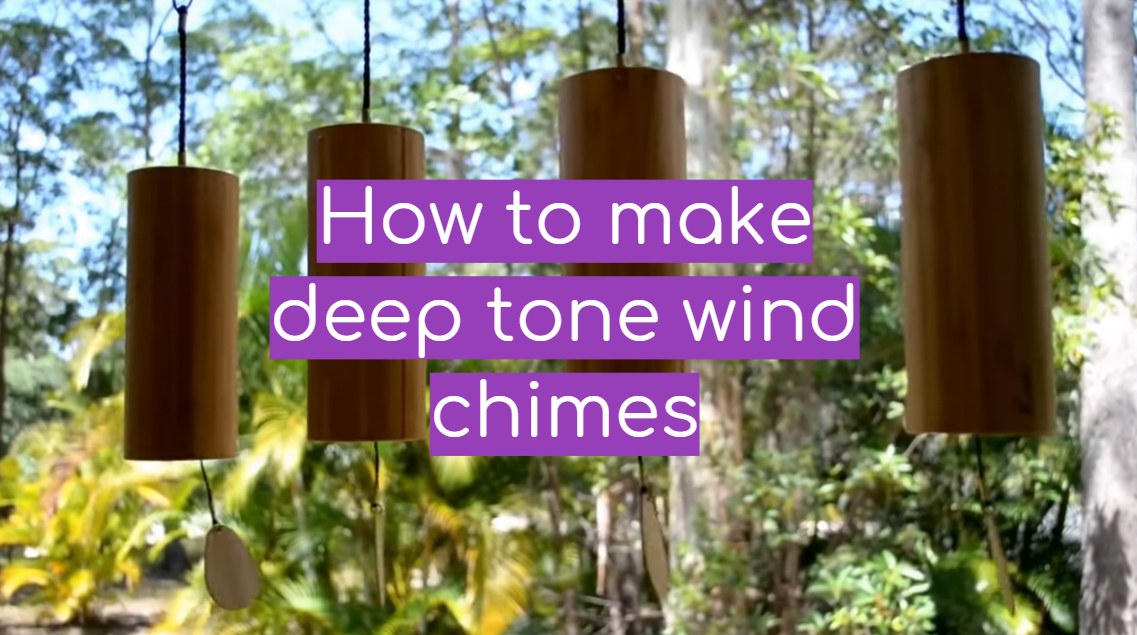Wanna make a deep tone wind chime? At first choose the most attractive chime design among their wide variety. Pay special attention to the practical stuff, such as the type of material, you are going to use, the shapes and thickness of pipes, the kinds of tone resonance.
Table of Contents
Special features: shapes and materials
Deep tone wind chimes or baritone wind chimes feature low frequency and soothing sounds which make them ideal for a relaxing atmosphere. They don’t differ a lot from the regular windchimes. The main secret is in the tubes, to be more precise in their length and thickness.
If you have one at home, you can modify it a little, shortening the pipes a bit, for example, with a saw. One more important characteristic is the material of the pipes. For deep baritone sounds wooden, or glass chimes will be the best. Though for DIY wind chimes these materials are uncomfortable. So try to use metal pipes. Give preference to softer metals like copper, or brass, rather than aluminum or steel.
You can use different metals to build the chime, though copper or brass are outrageously expensive which will increase the cost of the whole unit. However, steel is quite affordable. For example, a steel electrical conduit 10-foot section costs about $10. But it still sounds good.
As mentioned above the dimensions, the lengths and the thickness of the windchimes are top priority factors. In a few words, there are several main rules for a deep tone wind chime. The first is to make your pipes shorter. Be careful not to make them too short as they can spoil the sound or take the melody away at all. Choose thicker pipes, which means the inner diameter must be small, and the outer diameter has to be far bigger.
On the internet, you can find plenty of templates and other useful information about building windchimes. Search for the most preferable design and download the template, print it as you’re going to use it for cutting out the details. Besides, you must look for the correct dimensions to know how much material you need and how to work with it.
DIY Guidelines
Follow these simple guidelines to make your own deep tone wind chimes.
Step 1 Cut the pipe into pieces
Start with the pipe, cutting it into five pieces which will give you five different tones. Check all the dimensions of the required pieces depending on the material you are using, in the charts, which are available on the internet.
Step 2 Drill the holes at the optimum handing point
Using the same charts you can easily define the distance where the optimum heading point is located. With the help of a measuring tape and a marker put some marks on the pipe pieces. Later you can spray the pipe pieces in silver to make them look nicer.
Step 3 Prepare the rest of the parts
- The top
For other details, such as the top support disk, the striker, and the sail, you can use wood. Cut out the pieces with the abovementioned templates, and process them to get the ultimate look of your future windchimes. Now drill the holes in the wooden pieces and screw in the eyelets, which will hold the chime.
On the one side of the top support disk, there must be six eyelets, and on the other one, there will be three holes with eyelets that will hold the chains to hang the unit to the ceiling.
- The sail
Don’t drill the hole at the top of the sail, because the windchimes grab the air much better if the sail is slightly angled. Instead make a hole in the center, put a string through the hole, make a knot in the string. This way it will hang at the needed angle.
Step 4 Hang the pipes with the nylon cord
This part of the work is a little bit tricky. Take a long piece of the cord and make a slipknot in it. Take the loop and stick it to a dowel there, then fish it down into the pipe. Use some steel wire to catch that loop with, and send it through to the other side.
When the wire goes through the pipe, holding the slipknot, tighten the knot carefully.
Tug on it and press the wire in slightly. This way, the part of the wire inside the pipe will become V-shaped and won’t slide back and forth.
On both sides outside the pipe wrap the wire and create the loops to prevent it from sliding back inside of the hole. Repeat the same with all the pipes.
Step 5 Assemble the construction
Put the chain through the eyelets to hang it from the ceiling. Start fixing the pipes with the longest one, cinch it up close to the top support disc. Tie all the pipes to make them bottom aligned. This means that all the pipes are at about the same level at the bottom. This style of hanging the tubes makes the striker easily touch all the pieces and produce amazing tunes.
- The striker
To fix the striker put an eyelet through the hole. Use the coupling on the other side to hook another eyelet there. This type of fixture will make the striker go back and forth without flopping. The main thing about the striker is that we never fix it in the middle. You can choose either the top third or the lower third if you want to get the best sound. Tie on the wind sail to the central eyelet. Your own unique windchimes are ready, and now you can enjoy wonderful deep relaxing tunes.
Comparison of Numerical Data for Making Deep Tone Wind Chimes
This table compares various indicators for making deep tone wind chimes. It includes information on the length and diameter of pipes, as well as the material used, and the corresponding note or frequency produced by the wind chime.
| Material | Pipe Length (inches) | Pipe Diameter (inches) | Note/Frequency (Hz) |
|---|---|---|---|
| Bamboo | 22 | 1 | 262 |
| Aluminum | 27 | 1.5 | 194 |
| Copper | 24 | 1.25 | 220 |
| Steel | 18 | 1 | 294 |
| Brass | 20 | 1 | 262 |
This table provides an overview of some common materials used for making deep tone wind chimes, along with their corresponding pipe length, diameter, and the note or frequency they produce. Note that the length and diameter of pipes can greatly affect the pitch and overall sound of the wind chime. The materials listed here are just a few examples, and there are many other options available depending on personal preference and desired sound.
FAQ
What materials do I need to make deep tone wind chimes?
To make deep tone wind chimes, you will need the following materials:
- Aluminum tubing or pipes (different lengths)
- String or fishing line
- Drill and drill bits
- Saw or pipe cutter
- Sandpaper
- File
- Wooden dowel or stick
- Optional: decorative beads or charms
How do I cut the aluminum tubing for my wind chimes?
You can cut the aluminum tubing using a saw or a pipe cutter. Make sure to mark the tubing where you want to cut it and use the appropriate tool to make a straight cut. Once you have cut the tubing, use a file or sandpaper to smooth any rough edges or burrs.
What is the best length for the aluminum tubing to produce a deep tone?
The length of the aluminum tubing will determine the pitch of the sound. To produce a deep tone, you should use longer tubing. A good starting point is to use tubing that is between 1 and 2 inches in diameter and cut it into pieces that are between 12 and 24 inches in length. Experiment with different lengths to find the best tone for your wind chimes.
How do I attach the aluminum tubing to the wooden dowel or stick?
You can attach the aluminum tubing to the wooden dowel or stick using string or fishing line. Cut a length of string or fishing line and tie it to the end of the tubing. Then, tie the other end of the string to the wooden dowel or stick, making sure that the tubing hangs vertically. Repeat this process for each piece of tubing, spacing them out evenly along the dowel.
Can I add decorative beads or charms to my wind chimes?
Yes, you can add decorative beads or charms to your wind chimes. Simply string them onto the same string or fishing line that you are using to attach the tubing to the dowel. Make sure to space them out evenly and avoid adding too much weight, as this can affect the sound of the wind chimes.
How do I hang my wind chimes?
To hang your wind chimes, you can use a hook or hanger. Choose a location that is exposed to the wind, such as a porch or tree branch. Hang the wind chimes at a height where they will be able to move freely in the wind without hitting any obstructions. You can also experiment with different heights to find the best sound.
How do I tune my wind chimes?
To tune your wind chimes, you will need a musical instrument tuner. Hold the tuner near each piece of tubing and strike it with a mallet or other object. Adjust the length of the tubing until it produces the desired note. Repeat this process for each piece of tubing until all the notes are in harmony with each other. You can also experiment with different tunings to create unique sounds.
How do I care for my wind chimes?
To keep your wind chimes in good condition, you should clean them regularly. Use a soft cloth or brush to remove any dirt or debris, and polish the tubing with a metal cleaner to maintain their shine. If your wind chimes are exposed to harsh weather conditions, you may want to bring them inside during storms or extreme temperatures to prevent damage.
What are some tips for creating a unique wind chime design?
To create a unique wind chime design, you can experiment with different materials and shapes. For example, you could use bamboo or copper tubing instead of aluminum, or incorporate unusual objects like seashells or glass beads. You can also vary the length and diameter of the tubing to create different pitches and tones. Let your creativity guide you, and have fun exploring different possibilities!
How can I make my wind chimes louder?
To make your wind chimes louder, you can use thicker or wider tubing. This will produce a deeper and more resonant sound. You can also experiment with adding more tubing to your wind chime design to increase the overall volume. However, be careful not to add too much weight, as this can affect the sound quality.
Can I make wind chimes without aluminum tubing?
Yes, you can make wind chimes using a variety of materials, such as bamboo, wood, seashells, or glass. The key is to choose materials that produce a clear and resonant sound when struck or moved by the wind. Experiment with different materials and shapes to create a unique wind chime design that reflects your personal style and taste.
Conclusion
If you have a desire to make your own deep tone wind chimes remember some peculiarities of the design and construction of this instrument. Pick the tubes with larger diameter but still thick enough. The best materials are glass, wood, or soft metals, as they produce gorgeous deep sounds.






Leave a Reply